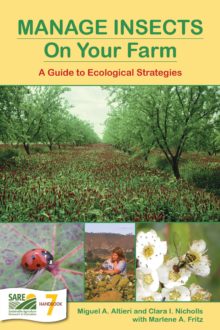Cropping Systems Shape Parasitoid Diversity
Most parasitoids used in the biological control of insect pests are either Diptera flies–especially from the family Tachinidae—or Hymenoptera wasps from the superfamilies Chalcidoidea, Ichneumonoidea and Proctotrupoidea (Table 4). Parasitoid diversity is directly related to plant diversity: different crops, ground covers, weeds and adjacent vegetation support different pests, which in turn attract their own groups of parasitoids.
In large-scale monocultures, parasitoid diversity is suppressed by vegetational simplification; in less-disturbed and pesticide-free agroecosystems, it is not unusual to find 11 to15 species of parasitoids hard at work. In many cases, just one or two species of parasitoids within these complexes prove vital to the natural biological control of primary insect pests.
In California’s alfalfa fields, the braconid wasp Cotesia medicaginis plays a pivotal role in regulating the alfalfa caterpillar. This pristine butterfly-wasp system apparently moved into irrigated alfalfa from native clovers.
